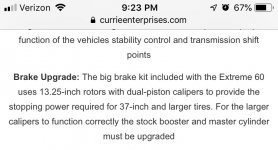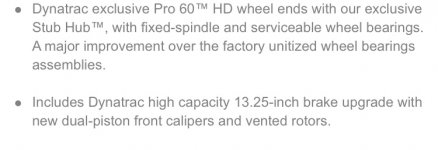I really wish we knew the pad compound used in all the available kits. We'd be able to do a much better on-paper comparison them all. Figuring out the braking mechanics (at least as far as clamping area and rotor diameter) isn't difficult.
Based on piston size, piston count, and rotor diameter we can compare them as if they had the same pad compound and hydraulic pressure.
The normal force, F, applied by the caliper will the piston area multiplied by the hydraulic pressure: F = A*P
The torque, call it tau, applied to the rotor is proportional to (not equal to because we don't know coefficient of friction of the pad) the caliper normal force multiplied by the distance from the center of rotation to the center of the piston (call it r): tau = F*r
Keep in mind that the distance from the center of the rotor to the center of the brake piston is not the diameter of the rotor. It's the radius of the rotor minus (roughly) the radius of the piston cylinder. The stock pistons are 66 mm in diameter (1.3 inch radius). The radius of the stock rotor is 5.95 inches; Dynatrac is 6.75 inches. The relative torque would be (6.75"-1.3")/(11.9"-1.3") = 1.17 or a 17% increase in stopping torque from the larger rotor. The rest of the gains come from the pad material.
I made a spreadsheet some time ago when I was deciding on my brakes. The spreadsheet did the above calculations and compared to the stock arrangement for many aftermarket kits. I found that the Dynatrac didn't fare well at all in the comparisons, even bearing in mind that Dynatrac also upgraded the rear brakes (KEEP IN MIND THAT THIS DOESN'T INCLUDE PAD MATERIAL). This is probably similar to what the OP and his friend did. The Teraflex kit had the best numbers of anything below $1500, while the Dynatrac kit had the worst numbers of anything over $1000.
To put numbers on it, I found that the Teraflex kit had a total mechanical advantage (torque and normal force combined) that was 70% greater than stock (assuming same pad material and fluid pressure). Consider that in a 60/40 front/rear braking scheme, that comes to about 40% increase for the total system just by upgrading the front brakes.
The Mopar kit (and the Crown/RT kit) ended up with about 55% increase in the front stopping torque, or 33% for the total system.
The Dynatrac kit ended up in the ballpark of 20% improvement for the total system.
The SSBC Tri-Power Caliper-only kit had about 20% improvement for the total system just by changing the front calipers (the exact opposite philosophy from Dynatrac but the same mechanical increase and can fit in smaller wheels).
The pad material and the pedal stroke required to get the same fluid pressure are the elephants in the room, obviously. A pad made with unobtainium is how Dynatrac gets such a good product using relatively modest geometry changes. More piston area means squishier pedal if you keep the same booster/master cylinder, which is a strike against the Teraflex and similar kits.
Mostly because of their reputation and cost, I couldn't bring myself to buy Terror-flex kit. However I also couldn't convince myself that Dynatrac was the best bang for the buck if so much of the performance comes from proprietary pads.
Obviously this is all on paper and I only write this up to show a quantitative approach to some of the options. Seemingly everyone who has the Dynatrac kit has been happy with it, so it's clearly great. I only offer this a way to compare what we do know about the specifications of each system.


